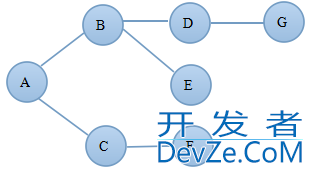Java编程实现基于图的深度优先搜索和广度优先搜索完整代码
为了解15puzzle问题,了解了一下深度优先搜索和广度优先搜索。先来讨论一下深度优先搜索(DFS),深度优先的目的就是优先搜索距离起始顶点最远的那些路径,而广度优先搜索则是先搜索距离起始顶点最近的那些路径。我想着深度优先搜索和回溯有什么区别呢?百度一下,说回溯是深搜的一种,区别在于回溯不保留搜索树。那么广度优先搜索(BFS)呢?它有哪些应用呢?答:最短路径,分酒问题,八数码问题等。言归正传,这里笔者用java简单实现了一下广搜和深搜。其中深搜是用图+栈实现的,广搜使用图+队列实现的,代码如下:
1.新建一个表示“无向图”类NoDirectionGraph
package com.wly.algorithmbase.datastructure;
/**
* 无向图
* @author wly
*
*/
public class NoDirectionGraph {
private int mMaxSize;
//图中包含的最大顶点数
private GraphVertex[] vertexList;
//顶点数组
private int[][] indicatorMat;
//指示顶点之间的连通关系的邻接矩阵
private int nVertex;
//当前实际保存的顶点数目
public NoDirectionGraph(int maxSize) {
mMaxSize = maxSize;
vertexList = new GraphVertex[mMaxSize];
indicatorMat = new int[mMaxSize][mMaxSize];
nVertex = 0;
//初始化邻接矩阵元素为0
for (int j=0;j<mMaxSize;j++) {
for (int k=0;k<mMaxSize;k++) {
indicatorMat[j][k] = 0;
}
}
}
public void addVertex(GraphVertex v) {
if(nVertex < mMaxSize) {
vertexList[nVertex++] = v;
} else {
System.out.println("---插入失败,顶点数量已达上限!");
}
}
/**
* 修改邻接矩阵,添加新的边
* @param start
* @param end
*http://www.devze.com/
public void addEdge(int start,int end) {
indicatorMat[start][end] = 1;
indicatorMat[end][start] = 1;
}
/**
* 打印邻接矩阵
*/
public void printIndicatorMat() {
for (int[] line:indicatorMat) {
for (int i:line) {
System.out.print(i + " ");
}
System.out.println();
}
}
/**
* 深度优先遍历
* @param vertexIndex 表示要遍历的起点,即图的邻接矩阵中的行数
*/
public void DFS(int vertexIndex) {
ArrayStack stack = new ArrayStack();
//1.添加检索元素到栈中
vertexList[vertexIndex].setVisited(true);
stack.push(vertexIndex);
int nextVertexIndex = getNextVertexIndex(vertexIndex);
while(!stack.isEmpty()) {
//不断地压栈、出栈,直到栈为空(检索元素也没弹出了栈)为止
if(nextVertexIndex != -1) {
vertexList[nextVertexIndex].setVisited(true);
stack.push(nextVertexIndex);
stack.printElems();
} else {
stack.pop();
}
//检索当前栈顶元素是否包含其他未遍历过的节点
if(!stack.isEmpty()) {
nextVertexIndex = getNextVertexIndex(stack.peek());
}
}
}
/**
* 得到当前顶点的下一个顶点所在行
* @param column
* @return
*/
public int getNextVertexIndex(int column) {
for (int i=0;i<indicatorMat[column].length;i++) {
if(indicatorMat[column][i] == 1 && !vertexList[i].isVisited()) {
return i;
}
}
return -1;
}
/**
* 广度优先遍历
* @param vertexIndex 表示要遍历的起点,即图的邻接矩阵中的行数
*/
public void BFS(int vertexIndex) {
ChainQueue queue = new ChainQueue();
vertexList[vertexIndex].setVisited(true);
queue.insert(new QueueNode(vertexIndex));
int nextVertexFjfziXIndex = getNextVertexIndex(vertexIndex);
while(!queue.ihttp://www.devze.comsEmpty()) {
if(nextVertexIndex != -1) {
vertexList[nextVertexIndex].setVisited(true);
queue.insert(new QueueNode(nextVertexIndex));
} else {
queue.remove();
}
if(!queue.isEmpty()) {
nextVertexIndex = getNextVertexIndex(queue.peek().data);
queue.printElems();
}
}
}
}
2.然后是一个用数组模拟的栈ArrayStack
package com.wly.algorithmbase.datastructure;
/**
* 使用数组实现栈结构
* @author wly
*
*/
public class ArrayStacwww.devze.comk {
private int[] tArray;
private int topIndex = -1;
//表示当前栈顶元素的索引位置
private int CAPACITY_STEP = 12;
//数组容量扩展步长
public ArrayStack() {
/***创建泛型数组的一种方法***/
tArray = new int[CAPACITY_STEP];
}
/**
* 弹出栈顶元素方法
* @return
*/
public int pop() {
if(isEmpty()) {
System.out.println("错误,栈中元素为空,不能pop");
return -1;
} else {
int i = tArray[topIndex];
tArray[topIndex--] = -1;
//擦除pop元素
return i;
}
}
/**
* 向栈中插入一个元素
* @param t
*/
public void push(int t) {
//检查栈是否已满
if(topIndex == (tArray.length-1)) {
//扩展容量
int[] tempArray = new int[tArray.length + CAPACITY_STEP];
for (int i=0;i<tArray.length;i++) {
tempArray[i] = tArray[i];
}
tArray = tempArray;
tempArray = null;
} else {
topIndex ++;
tArray[topIndex] = t;
}
}
/**
* 得到栈顶元素,但不弹出
* @return
*/
public int peek() {
if(isEmpty()) {
System.out.println("错误,栈中元素为空,不能peek");
return -1;
} else {
return tArray[topIndex];
}
}
/**
* 判断当前栈是否为空
* @return
*/
public Boolean isEmpty() {
return (topIndex < 0);
}
/**
* 打印栈中元素
*/
public void printElems() {
for (int i=0;i<=topIndex;i++) {
System.out.print(tArray[i] + " ");
}
System.out.println();
}
}
3.在一个用链表模拟的队列ChainQueue
package com.wly.algorithmbase.datastructure;
/**
* 使用链表实现队列
*
* @author wly
*
*/
public class ChainQueue {
private QueueNode head;
// 指向队列头节点
private QueueNode tail;
// 指向队列尾节点
private int size = 0;
// 队列尺寸
public ChainQueue() {
}
/**
* 插入新节点到队列尾
开发者_Python入门 */
public void insert(QueueNode node) {
// 当然也可以这么写,添加tail.prev = node
if (head == null) {
head = node;
tail = head;
} else {
node.next = tail;
tail.prev = node;
// 双向连接,确保head.prev不为空
tail = node;
}
size++;
}
/**
* 移除队列首节点
*/
public QueueNode remove() {
if (!isEmpty()) {
QueueNode temp = head;
head = head.prev;
size--;
return temp;
} else {
System.out.println("异常操作,当前队列为空!");
return null;
}
}
/**
* 队列是否为空
*
* @return
*/
public Boolean isEmpty() {
if (size > 0) {
return false;
} else {
return true;
}
}
/**
* 返回队列首节点,但不移除
*/
public QueueNode peek() {
if (!isEmpty()) {
return head;
} else {
System.out.println();
System.out.println("异常操作,当前队列为空!");
return null;
}
}
/**
* 返回队列大小
*
* @return
*/
public int size() {
return size;
}
/**
* 打印队列中的元素
*/
public void printElems() {
QueueNode tempNode = head;
while(tempNode != null) {
System.out.print(tempNode.data + " ");
tempNode = tempNode.prev;
}
System.out.println();
}
}
/**
* 节点类
*
* @author wly
*
*/
class QueueNode {
QueueNode prev;
QueueNode next;
int data;
public QueueNode(int data) {
this.data = data;
}
public int getData() {
return data;
}
public void setData(int data) {
this.data = data;
}
@Override
public String toString() {
// TODO Auto-generated method stub
super.toString();
return data + "";
}
}
4.测试一下Test_BFS_DFS
package com.wly.algorithmbase.search;
import com.wly.algorithmbase.datastructure.GraphVertex;
import com.wly.algorithmbase.datastructure.NoDirectionGraph;
/**
* 基于图的深度优先搜索
* @author wly
*
*/
public class Test_BFS_DFS {
public static void main(String[] args) {
//初始化测试数据
NoDirectionGraph graph = new NoDirectionGraph(7);
graph.addVertex(new GraphVertex("A"));
graph.addVertex(new GraphVertex("B"));
graph.addVertex(new GraphVertex("C"));
graph.addVertex(new GraphVertex("D"));
graph.addVertex(new GraphVertex("E"));
graph.addVertex(new GraphVertex("F"));
graph.addVertex(new GraphVertex("G"));
graph.addEdge(0, 1);
graph.addEdge(0, 2);
graph.addEdge(1, 3);
graph.addEdge(1, 4);
graph.addEdge(3, 6);
graph.addEdge(2, 5);
System.out.println("--图的邻接矩阵--");
graph.printIndicatorMat();
//测试深搜
System.out.println("--深度优先搜索--");
graph.DFS(0);
graph = new NoDirectionGraph(7);
graph.addVertex(new GraphVertex("A"));
graph.addVertex(new GraphVertex("B"));
graph.addVertex(new GraphVertex("C"));
graph.addVertex(new GraphVertehttp://www.devze.comx("D"));
graph.addVertex(new GraphVertex("E"));
graph.addVertex(new GraphVertex("F"));
graph.addVertex(new GraphVertex("G"));
graph.addEdge(0, 1);
graph.addEdge(0, 2);
graph.addEdge(1, 3);
graph.addEdge(1, 4);
graph.addEdge(3, 6);
graph.addEdge(2, 5);
System.out.println("--广度优先搜索--");
graph.BFS(0);
}
}
这里测试的图结构如下:

运行结果如下:
--图的邻接矩阵-- 0 1 1 0 0 0 0 1 0 0 1 1 0 0 1 0 0 0 0 1 0 0 1 0 0 0 0 1 0 1 0 0 0 0 0 0 0 1 0 0 0 0 0 0 0 1 0 0 0 --深度优先搜索-- 0 1 0 1 3 0 1 3 6 0 1 4 0 2 0 2 5 --广度优先搜索-- 0 1 0 1 2 1 2 1 2 3 1 2 3 4 2 3 4 2 3 4 5 3 4 5 3 4 5 6 4 5 6 5 6 6
这里需要说明一下上面深搜和广搜的运行结果,其中0,1,2,3…分别对应着A,B,C,D...有点绕哈,,见谅~~
O啦~~~总结
以上就是本文关于Java编程实现基于图的深度优先搜索和广度优先搜索完整代码的全部内容,希望对大家有所帮助。感兴趣的朋友可以继续参阅本站其他相关专题,如有不足之处,欢迎留言指出。感谢朋友们对本站的支持!






 加载中,请稍侯......
加载中,请稍侯......
精彩评论